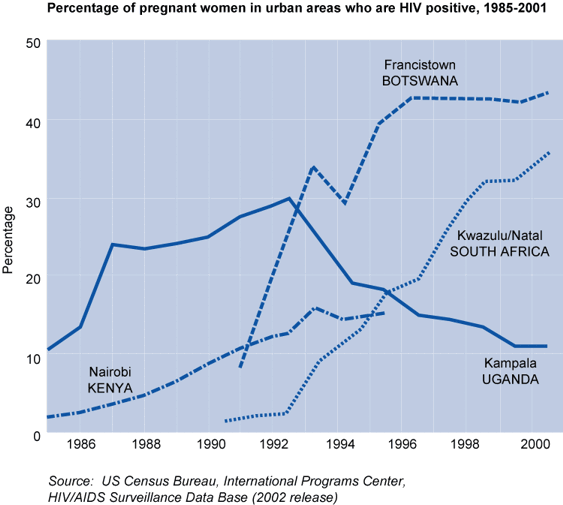
By 2003 the countries of southern Africa had the highest rates by far, and they seemed to be increasing. But this isn't necessarily the same for all countries and from the graph above, it's clear to see the differences between the countries.
The graph shows data on the percentage of pregnant women who are HIV+ for the capital cities of Kenya (Nairobi) and Uganda (Kampala) and for Francistown (the second city of Botswana) and for Kwazulu/Natal the most affected province of South Africa. These are representative of overall trends in these countries.
Differences and reasons for these differences
One of the most obvious differences is between Uganda (where rates have fallen) and the other three countries where rates are still increasing.
Uganda was the most affected country up till about 1993, but since then it has been overtaken by most of the countries to the south.
Uganda is the only country in Africa where prevalence rates have fallen. The 2003 rate for Uganda is about 7%. This is much lower than the rates in the 1990s.
There are many reasons why Uganda is unique in having falling HIV rates, but the most important factor is the political leadership shown by President Museveni.
President Museveni regularly and colourfully encouraged open discussion of the problem of AIDS and the need for behavioural change - fewer sexual partners and ‘safe sex' and abstinence.
This stands in great contrast to South Africa where rates were much lower than in Uganda or Kanya until about 1992. Up till 2003 there was political denial about the growing prevalance of AIDSat the highest levels of government, notably by President Thabo Mbeki.
Most recent data suggest that the African epidemic may be plateauing at the national scale, in Eastern and Southern Africa, and we can see this on the graph in the case of Botswana. The line for Botswana seems to be levelling off.
Data for 2002 (the most recently comparable data available) do not show large increases over previous data. However, no other countries have experienced the declines indicated above for Uganda.